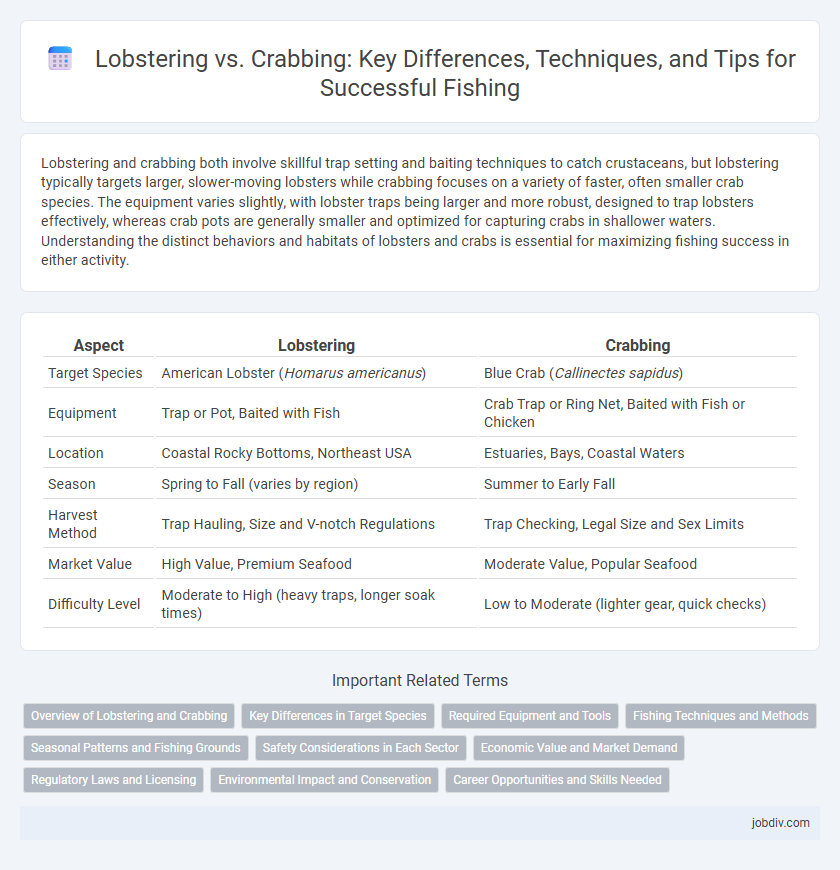Lobstering and crabbing both involve skillful trap setting and baiting techniques to catch crustaceans, but lobstering typically targets larger, slower-moving lobsters while crabbing focuses on a variety of faster, often smaller crab species. The equipment varies slightly, with lobster traps being larger and more robust, designed to trap lobsters effectively, whereas crab pots are generally smaller and optimized for capturing crabs in shallower waters. Understanding the distinct behaviors and habitats of lobsters and crabs is essential for maximizing fishing success in either activity.
Table of Comparison
| Aspect | Lobstering | Crabbing |
|---|---|---|
| Target Species | American Lobster (Homarus americanus) | Blue Crab (Callinectes sapidus) |
| Equipment | Trap or Pot, Baited with Fish | Crab Trap or Ring Net, Baited with Fish or Chicken |
| Location | Coastal Rocky Bottoms, Northeast USA | Estuaries, Bays, Coastal Waters |
| Season | Spring to Fall (varies by region) | Summer to Early Fall |
| Harvest Method | Trap Hauling, Size and V-notch Regulations | Trap Checking, Legal Size and Sex Limits |
| Market Value | High Value, Premium Seafood | Moderate Value, Popular Seafood |
| Difficulty Level | Moderate to High (heavy traps, longer soak times) | Low to Moderate (lighter gear, quick checks) |
Overview of Lobstering and Crabbing
Lobstering involves trapping large American lobsters using baited traps placed on the ocean floor, primarily in cold Atlantic waters where the species thrives. Crabbing targets various crab species, commonly blue crabs and Dungeness crabs, using circular traps or nets in coastal and estuarine environments. Both fisheries require specific permits and seasonal regulations to maintain sustainable populations and protect marine ecosystems.
Key Differences in Target Species
Lobstering targets large marine crustaceans like the American lobster (Homarus americanus), known for their hard shells and sizable claws, primarily found off the northeastern coast of North America. Crabbing focuses on various species of crabs, such as blue crabs (Callinectes sapidus) and Dungeness crabs (Metacarcinus magister), which have broader, flatter bodies and are commonly harvested in coastal waters worldwide. The primary difference lies in the species' morphology and habitat preference, influencing the type of traps and fishing methods used in each fishery.
Required Equipment and Tools
Lobstering requires sturdy lobster traps, often rectangular and made of wire mesh, equipped with bait bags and escape vents to target lobsters specifically. Crabbing uses collapsible crab pots or traps with funnel-shaped entrances, designed to catch various crab species while allowing smaller crabs to escape. Both methods depend on durable buoys and heavy-duty ropes for marking and retrieving traps in coastal fishing areas.
Fishing Techniques and Methods
Lobstering primarily employs trap or pot fishing, where baited cages are strategically placed on the seafloor to attract lobsters, minimizing habitat disturbance. Crabbing uses similar pots but often incorporates bait types and placement depths tailored to crab species, maximizing catch efficiency. Both methods rely on periodic hauling of traps, with lobstering typically requiring specific escape vents to reduce bycatch and support sustainability.
Seasonal Patterns and Fishing Grounds
Lobstering peaks from late spring to early fall, primarily in cold Atlantic waters such as Maine and Canada, where rocky seabeds provide ideal habitats. Crabbing thrives in warmer months across estuaries and coastal bays, particularly in the Chesapeake Bay and Pacific Northwest, favoring muddy or sandy bottoms. Seasonal patterns and geographic preferences for lobstering and crabbing dictate the optimal fishing grounds and harvesting windows for each species.
Safety Considerations in Each Sector
Lobstering involves heavy traps and rough sea conditions, requiring robust safety gear and training to prevent injuries from handling powerful equipment and strong currents. Crabbing, while less physically intensive, still demands vigilance against risky boat maneuvers and exposure to cold, necessitating proper flotation devices and weather preparedness. Both sectors emphasize emergency communication tools and adherence to maritime safety regulations to reduce accidents and ensure crew well-being.
Economic Value and Market Demand
Lobstering generates higher economic value compared to crabbing due to the premium prices lobsters command in global seafood markets, driven by consistent demand and limited supply. Crabbing, while widespread and producing significant quantities, often experiences more volatile market prices influenced by seasonal availability and regional consumer preferences. The sustained market demand for lobster, particularly in luxury dining sectors, ensures greater profitability for lobstermen relative to the generally lower-priced, though stable, crab market.
Regulatory Laws and Licensing
Lobstering and crabbing are governed by distinct regulatory laws and licensing requirements that vary by region and are crucial for sustainable harvest practices. Lobstering often requires specialized lobster trap licenses, adherence to strict trap limits, and seasonal restrictions to protect breeding populations, while crabbing regulations may focus on pot specifications, size limits, and catch quotas. Compliance with these laws ensures the conservation of marine ecosystems and supports legal, accountable commercial and recreational fishing activities.
Environmental Impact and Conservation
Lobstering and crabbing both influence marine ecosystems, but lobstering can cause more habitat disruption due to trap placement on seafloors, impacting benthic communities. Crabbing often entails less seabed disturbance and relies on more selective traps, which can reduce bycatch and help preserve non-target species. Effective regulations and sustainable practices in both fisheries are essential to minimize overharvesting and support long-term population health.
Career Opportunities and Skills Needed
Lobstering offers career opportunities primarily in coastal regions with rocky seabeds, requiring skills in trap setting, navigation, and boat maintenance, while crabbing is prevalent in estuarine and coastal waters, demanding expertise in crab pot deployment, species identification, and handling live catch. Both careers require physical endurance, knowledge of local regulations, and the ability to operate and maintain fishing vessels safely. Advanced skills in sustainable harvesting and market knowledge enhance income potential in lobstering and crabbing industries.
Lobstering vs Crabbing Infographic

 jobdiv.com
jobdiv.com